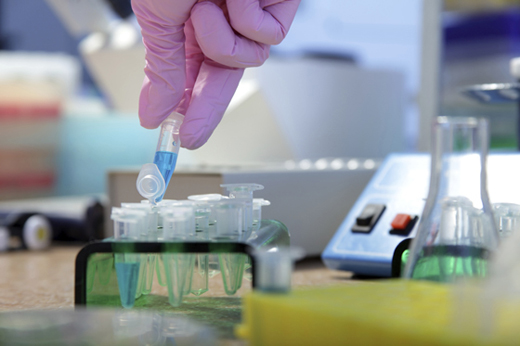Researchers at Emory University received $572.4 million from external funding agencies in fiscal year 2015, a 9.69 percent increase over last fiscal year. This marks the largest amount of research funding in Emory’s history and is the sixth consecutive year that research funding has exceeded $500 million.
Federal agencies awarded nearly $375 million, or nearly 66 percent of the total, led by the National Institutes of Health (NIH) with nearly $300 million in awards. NIH funding represented 80 percent of total federal dollars awarded to Emory.
"Even though the NIH budget has remained flat, our researchers have held their own in NIH funding while managing to attract new support from other government and non-government sources," says David Stephens, MD, vice president for research in Emory’s Woodruff Health Sciences Center and chair of the Department of Medicine in Emory University School of Medicine. "These numbers are truly heartening and impressive."
Researchers in Emory’s Woodruff Health Sciences Center (WHSC) received more than $537 million in FY15, or nearly 94 percent of the University total, with $348.4 million in federal funding, including $286.5 million from the NIH. The WHSC includes schools of medicine, public health, nursing, Yerkes National Primate Research Center, Winship Cancer Institute and Emory Healthcare.
Emory University School of Medicine received nearly $363 million; the Rollins School of Public Health received $90 million, Yerkes National Primate Research Center received $66.6 million, and Emory’s Nell Hodgson Woodruff School of Nursing received $14.3 million.
The value of biomedical research extends well beyond new cures and disease treatment and prevention, says Stephens. In Georgia, nearly 19 high-paying jobs are generated per $1 million in research funding. And university research discoveries often are translated into commercial applications that positively impact the economy while offering medical advances to patients more quickly.
Examples of Emory funded research projects in fiscal year 2015 include:
- $9 million over five years from the NIH to Emory School of Medicine to support one of three national Centers for Collaborative Research in Fragile X. The grant is a renewal of Emory’s National Fragile X Research Center, continuously funded by the NIH for more than 10 years.
- $2.5 million over five years from the Fogarty International Center to the Rollins School of Public Health and the University of South Florida’s College of Arts and Sciences to study links between infectious disease transmission and agricultural practices.
- $18.7 million over seven years from the NIH to Emory School of Medicine to lead one of four national Tuberculosis Research Units working to improve diagnosis, prevention, vaccines and drug therapies.
- $10.8 million over three years from the Defense Advanced Research Projects Agency (DARPA) to Emory School of Medicine and the Emory Vaccine Center to lead a 10-institution national team developing improved therapeutics and vaccines for multiple strains of Ebola virus.
- $3.4 million from the NIH International Collaborations in Infectious Disease Research Program to support a partnership between the Emory Vaccine Center and the International Centre for Genetic Engineering and Biotechnology (ICGEB) in New Delhi, India to study dengue virus infection in India.
- • $15 million over five years from the NIH to Emory School of Medicine, Yerkes National Primate Research Center, and the Emory Vaccine Center for renewal of a “systems vaccinology” grant to better understand and improve immune responses to vaccines, focusing on infants, the elderly, and transplant recipients.
- $1.8 million over four years from the Cystic Fibrosis Foundation to Emory School of Medicine, Children’s Healthcare of Atlanta and Georgia Tech to establish the Atlanta CF Research and Development Program. The grant will expand current research programs and translate the results more effectively to patients.
- $8.9 million over five years from the National Heart, Lung and Blood Institute of the NIH to Emory School of Medicine to better understand the role of reactive oxygen species and inflammation in blood vessel function and to explore new interventions and preventive approaches for atherosclerosis and aortic aneurysms.
- $72 million over three years from the Bill & Melinda Gates Foundation to the Emory Global Health Institute to establish the Child Health and Mortality Prevention Surveillance network (CHAMPS), aimed at preventing childhood mortality in developing countries, particularly in sub-Saharan Africa and south Asia. CHAMPS will partner with the International Association of National Public Health Institutes (IANPHI), the CDC, the Public Health Informatics Institute of the Task Force for Global Health, and Deloitte Consulting LLP.
- $1.6 million from the Coulter Translational Research Partnership Program to Emory School of Medicine and Georgia Tech to accelerate nine promising technologies developed in research laboratories with commercialization potential.
- $3.6 million over five years from the NIH to Emory School of Nursing to examine the effects of maternal stress on brain function, development, and behavior in African-American infants, including the biochemical connection between the brain and the microbiome.
- $8 million over five years from the NIH to Emory College, Emory School of Medicine, and the Emory Vaccine Center to develop and validate mathematical models of how prior immunity affects recall immune responses to influenza viruses. The researchers will create and disseminate powerful, user-friendly modeling tools for use by the wider research community in developing more effective vaccines.
- $3.5 million over five years from the National Cancer Institute for an Informatics Technology for Cancer Research award. Winship Cancer Institute and Emory School of Medicine researchers will develop software tools to help the cancer research community gain new insights from cancer imaging “big data” and develop new open-source cancer research applications.

